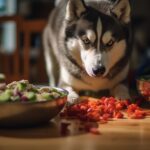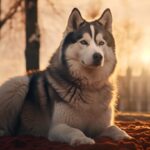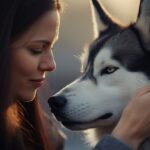Introduction: The Husky Breed and Their Unique Coat
The Siberian Husky, a breed known for its striking blue or multicolored eyes and wolf-like features, is a popular choice for dog lovers worldwide. Originating from the harsh climates of Siberia, these dogs were bred to endure extreme cold, thanks to their thick double coat. This coat, a marvel of nature, is not just for show. It serves a vital purpose, providing insulation against the cold and protection from the heat.
The Husky’s coat is a two-layered affair. The top layer, or guard hairs, are straight and somewhat coarse, protecting the dog from UV rays and insects. Underneath lies a softer, denser undercoat that traps air to insulate the dog from both cold and heat. This unique coat is what gives Huskies their fluffy appearance and is also the source of a common question among potential Husky owners: Do Huskies shed?
The short answer is yes. Huskies do shed, and they shed quite a bit. But there’s more to the story than just a simple yes or no. So, let’s dive into the world of Husky shedding and unravel the truth.
Understanding the Husky’s Shedding Cycle
Huskies, like many other breeds, go through a shedding cycle. However, their cycle is a bit more dramatic than most. Twice a year, typically in spring and fall, Huskies will “blow” their undercoat. This is a process where they shed their entire undercoat to prepare for the changing seasons. During these periods, you might feel like you’re living in a snow globe of fur.
In between these major shedding events, Huskies will continue to lose hair, albeit at a much slower rate. This is normal and part of the natural renewal process of their coat. It’s also worth noting that individual Huskies may have slightly different shedding patterns based on their health, diet, and environment.
Factors Influencing Husky Shedding
Several factors can influence the amount and frequency of Husky shedding. Age, for instance, plays a role. Puppies will shed their fluffy puppy coat and grow their adult coat, which can result in a temporary increase in shedding.
Diet and nutrition also have a significant impact. A diet rich in essential fatty acids can help promote a healthy coat and minimize excessive shedding. On the other hand, a poor diet can lead to a dull coat and increased hair loss.
Health issues can also cause abnormal shedding. If your Husky is shedding excessively or out of season, it might be worth a trip to the vet to rule out any underlying health problems.
Debunking Myths About Husky Shedding
There are many myths surrounding Husky shedding. One common myth is that Huskies are hypoallergenic because they have a similar coat to some hypoallergenic breeds. This is not true. Huskies produce the same allergens as other dogs and their heavy shedding can actually make allergies worse.
Another myth is that shaving a Husky will reduce shedding. This is not only false but can be harmful to the dog. The Husky’s double coat protects them from both heat and cold, and removing it can lead to overheating in summer and hypothermia in winter. It can also cause the coat to grow back unevenly, leading to long-term damage.
Practical Tips for Managing Husky Shedding
While you can’t stop a Husky from shedding, there are ways to manage it. Regular brushing is the most effective way to keep shedding under control. During shedding season, daily brushing can help remove the loose undercoat before it ends up on your furniture.
Investing in a good vacuum cleaner is also a must for any Husky owner. Look for one designed to pick up pet hair. Regular bathing can also help, but be careful not to overdo it as it can dry out their skin and coat.
Conclusion: Embracing the Reality of Husky Shedding
In conclusion, Husky shedding is a fact of life. It’s a natural part of their biology and a testament to their resilience in harsh climates. While it can be a challenge to manage, with the right tools and a bit of patience, it’s entirely manageable.
Owning a Husky means embracing the fluff. It means finding dog hair in places you didn’t know dog hair could reach. But it also means having a loyal, energetic, and loving companion. And in the end, isn’t that worth a little extra vacuuming?






